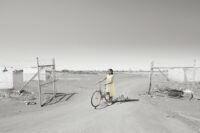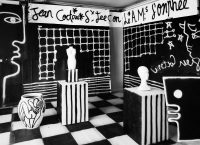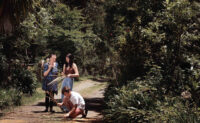guide
Portraiture Remixed
by Elias Redstone
New technologies are offering a whole spectrum of new opportunities to alter, adapt and reinvent the photographic portrait. From FaceTuning your selfie to Deepfakes of Donald Trump, the relationship between what we see and what we believe is increasingly being called into question. Artists are embracing new technologies—and rethinking old ones—to question the truth behind the image.
Broomberg & Chanarin employed a facial recognition system developed in Moscow for ‘public security and border control surveillance’ to take portraits of unsuspecting Russian citizens—including a member of Pussy Riot—to explore how machines make and see images, in turn raising complicated questions about consent in photography. In a new commission for PHOTO 2021, Hoda Afshar has created a new suite of portraits of people that have blown the whistle, using 3D-scanning technology. She has photographed the 3D prints, creating a haunting image that is reminiscent of Greek statues and tragedies. Finnish artist Maija Tammi steps away from the human subject altogether, with portraits of androids and (maybe) one human.
Responding to complex questions around photography, representation and agency, British artist Patrick Waterhouse has made portraits with the Warlpiri of Central Australia, where the subjects have painted over photographs as an act of personal advocacy and reclamation. Zanele Muholi makes portraits that are constant reminders about how political the human body—and the visibility of black lesbian, gay, bisexual, transgender and intersex people—continues to be. Jody Haines brings a feminist perspective to portraiture, and Atong Atem adds layers of fantasy and illusion to her photographs of diaspora communities in Melbourne. See also Sara Oscar’s homage to the police mugshot and Shea Kirk’s stunning stereoscopic portraits of Melburnians. These artists and more provide an insight into how portraiture is not as simple as we once might have thought, and how the rupture between image and reality is ever increasing.
—Elias Redstone, Artistic Director, PHOTO 2021
![Image: Broomberg & Chanarin, [The Revolutionary], from the series [Spirit is a bone], 2013. Courtesy the artists.](https://photo.org.au/api/wp-content/uploads/2020/02/The-Revolutionary-200x136.jpg)
![Image: Hoda Afshar, [Agonistes (still)] 2020, 1-channel digital video, colour, sound. Courtesy and © the artist and
Milani Gallery, Brisbane.](https://photo.org.au/api/wp-content/uploads/2020/02/Agonisties-Stills-020-200x112.jpg)
![Image: Maija Tammi, [One of Them is Human 1] (detail), 2017.](https://photo.org.au/api/wp-content/uploads/2020/02/one_of_them_is_a_human_1_large_file-185x200.jpg)
![Image: Alec Soth, [Adelyn, Ash Wednesday, New Orleans, Louisiana] (detail), from the series Sleeping by the
Mississippi, 2000. Courtesy the artist.](https://photo.org.au/api/wp-content/uploads/2020/02/Alec-Soth-Adelyn-Ash-Wednesday-New-Orleans-Louisiana2000-from-the-series-Sleeping-by-the-Mississippi.-200x160.jpg)
![Image: George Georgiou, [Algiers, New Orleans] from the series [Americans Parade], 2016.](https://photo.org.au/api/wp-content/uploads/2020/02/Algiers-New-Orleans-154-200x133.jpg)
![Image: Michael Cook [Livin’ the dream (Welcome Home)], 2020. Courtesy the artist and THIS IS NO FANTASY.](https://photo.org.au/api/wp-content/uploads/2020/10/2-MCLivintheDreamWelcomeHome-200x133.jpg)

![Image: James Tylor, [Economics of Minerals] (detail), 2020.](https://photo.org.au/api/wp-content/uploads/2020/02/Economics-of-Minerals-2-2020-Silver-Vinyl-on-photographic-paper-100x100cm-200x200.jpg)
![Image: Ruth Maddison, [My parents gave me a colourful life (1976)], 2020.](https://photo.org.au/api/wp-content/uploads/2020/10/Ruth-Maddison-My-parents-gave-me-a-colourful-life-1976-inkjet-pint-on-rag-paper-2020-200x134.jpg)
![Image: Pat Brassington, [Flushed], 2019. Courtesy the artist and ARC ONE Gallery.](https://photo.org.au/api/wp-content/uploads/2020/02/Brassington_Flushed_2019_75-x-75-cm_Courtesy-of-the-artist-and-ARC-ONE-200x200.jpg)
![7_-an-invitation-to-dance-Ann-Shelton©-border-crop Image: Ann Shelton, [an invitation to dance] (detail), 2020.](https://photo.org.au/api/wp-content/uploads/2020/11/7_-an-invitation-to-dance-Ann-Shelton©-border-crop-1-155x200.jpg)
![Image: Leyla Stevens, [A Line in the Sea], 2019. Courtesy the artist.](https://photo.org.au/api/wp-content/uploads/2020/02/A-Line-in-the-Sea-2019-3-channel-video_02-200x113.jpg)
![Image: Shea Kirk, [Sam Biddle] (left and right view), 2019.](https://photo.org.au/api/wp-content/uploads/2020/02/SheaKirk_VANTAGES_DAINESINGER2021_promo_04_Sam_Biddle-200x125.jpg)
![Image: Laura Delaney, [The Rise and Fall] (detail), 2020. Image: Laura Delaney, [The Rise and Fall] (detail), 2020.](https://photo.org.au/api/wp-content/uploads/2020/02/Laura-Delaney-The-Rise-and-Fall-Detail-1-200x141.jpg)
![Image: Zanele Muholi, [Nomthetho Vingi, Arcadia, Port Elizabeth] (detail), 2017. Courtesy Stevenson, Cape Town/
Johannesburg and Yancey Richardson, New York © Zanele Muholi.](https://photo.org.au/api/wp-content/uploads/2020/02/Nomthetho-Vingi-Arcadia-Port-Elizabeth-2017-IMG_6802-VVG-FINAL-crop-132x200.jpg)
![Image: Zanele Muholi, [Hlonipha, Cassilhaus, Chapel Hill, North Carolina], 2016. Courtesy Stevenson, Cape Town/
Johannesburg and Yancey Richardson, New York. ©Zanele Muholi.](https://photo.org.au/api/wp-content/uploads/2020/02/Hlonipha-Cassilhaus-Chapel-Hill-North-Carolina-2016_0491OP-133x200.jpg)
![Image: Atong Atem, [Saba and Gabby], 2020. Courtesy the artist and MARS Gallery.](https://photo.org.au/api/wp-content/uploads/2020/02/Atong-web-thumbnail-crop-200x123.jpg)
![Image: Grace Wood, [Abundance; scattered] (study for Rose Pavilion), 2020. Found images, digital collage. Images sourced from the State Botanical Collection, Royal Botanic Gardens Victoria and the artist’s personal archive.](https://photo.org.au/api/wp-content/uploads/2020/02/Grace-Wood-Abundance-scattered-study-for-Rose-Pavilion-2020-150x200.jpg)
![Image: Filippo Menichetti and Martin Errichiello, from [In Fourth Person]. Courtesy the artists.](https://photo.org.au/api/wp-content/uploads/2020/02/InFourthPerson-1-200x162.jpg)
![Undercurrent_Peta Clancy Peta Clancy, [Undercurrent], 2018-19, inkjet pigment print. Courtesy the artist and Dominik Mersch Gallery.](https://photo.org.au/api/wp-content/uploads/2020/12/Undercurrent_Peta-Clancy-200x142.jpg)
![Image: Justine Varga, [Vicissitude], 2018-19.](https://photo.org.au/api/wp-content/uploads/2020/02/Justine-Varga_Vicissitude_2018-19-158x200.jpg)
![Image: Izabela Pluta, [Iterative composition 1979 (pages 17-18 Australia)], 2020. Courtesy the artist and Gallery Sally Dan-Cuthbert, Sydney.](https://photo.org.au/api/wp-content/uploads/2020/10/10.-Izabela-PLUTA_Iterative_composition_australia2020-200x125.jpg)
![Window Shopping Aaron Christopher Rees, [Window Shopping], 2020. Courtesy the artist.](https://photo.org.au/api/wp-content/uploads/2021/01/aaron-rees-200x133.jpg)
![Image: Simon Fujiwara, [Joanne], 2016/2018. Courtesy the artist; FVU, The Photographers’ Gallery; Ishikawa Foundation; and Esther Schipper, Berlin. Film still © the artist.](https://photo.org.au/api/wp-content/uploads/2020/02/vlcsnap-2016-11-14-11h31m43s150-200x112.jpeg)
![Kenta Cobayashi Photographic Universe 2020 Image: Kenta Cobayashi, [Photographic Universe]
(detail), 2020.](https://photo.org.au/api/wp-content/uploads/2020/11/Kenta-Cobayashi-Photographic-Universe-2020-200x141.jpg)
![Image: Agnieszka Polska, [The New Sun (Tear)] (detail), 2017. Courtesy Żak Branicka, Berlin and Overduin & Co.,
Los Angeles © the artist.](https://photo.org.au/api/wp-content/uploads/2020/02/New-Sun-Tear_print_70x70-200x200.jpg)

![Image: Lauren Dunn, [Shopping for eggs], 2020.](https://photo.org.au/api/wp-content/uploads/2020/02/LDunn-New-Romanticism-Shopping-for-eggs-47-x-70-cm-type-C-print-200x134.jpg)
![Eliza Hutchison, Just wanted you to know Eliza Hutchison, from the series [Just wanted you to know], 2020-21. Courtesy the artist.](https://photo.org.au/api/wp-content/uploads/2021/02/Eliza-new-image-200x125.jpg)
![Image: Ali McCann, [Continuous Relief], 2018. Courtesy the artist.](https://photo.org.au/api/wp-content/uploads/2020/01/Ali-McCann_Continuous-Relief_2018-160x200.jpg)
![Image: Emmanuelle Andrianjafy, from the series
[Nothing’s in Vain], 2017.](https://photo.org.au/api/wp-content/uploads/2020/03/Nothings-in-vain-web-thumbnail-crop-200x123.jpg)
![Image: Sam Contis, [Beating Time, Movement of the Hand (After Lange)] (detail), 2020. Courtesy the artist.](https://photo.org.au/api/wp-content/uploads/2020/02/Contis_Beating-Time_detail-2-200x124.jpg)
![J Davies HERO WEB Image: J Davies, from the series [Love Story], 2022. Courtesy the artist.](https://photo.org.au/api/wp-content/uploads/2022/02/J-Davies-HERO-WEB-132x200.jpg)
![HERO WEB A conversation around pictures (0X5A5079), 2019, 50 x 75 inches Image: Paul Mpagi Sepuya, [Studio (0X5A5038)], 2020. Image courtesy of the artist, DOCUMENT, Chicago, and Vielmetter Los Angeles.](https://photo.org.au/api/wp-content/uploads/2022/02/HERO-WEB-A-conversation-around-pictures-0X5A5079-2019-50-x-75-inches-133x200.jpg)


![Christian Thompson Being Human Human Being Image: Christian Thompson, [Being Human Human Being], 2022. Commissioned by Photo Australia for PHOTO 2022 International Festival of Photography. Courtesy the artist, Sarah Scout Presents and Yavuz Gallery.](https://photo.org.au/api/wp-content/uploads/2022/01/Christian-Thompson-Being-Human-Human-Being-200x200.jpg)
![Naomi Hobson, Fish Boys Image: Naomi Hobson, [Fish Boys] (detail), 2022, from the series [Adolescent Wonderland]. Commissioned by Photo Australia for PHOTO 2022 International Festival of Photography. Courtesy the artist.](https://photo.org.au/api/wp-content/uploads/2022/02/Naomi-Hobson-Fish-Boys-e1645577735460-200x134.jpg)